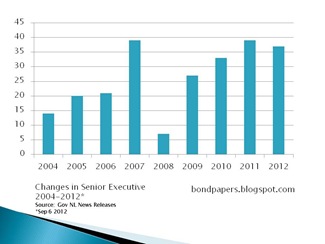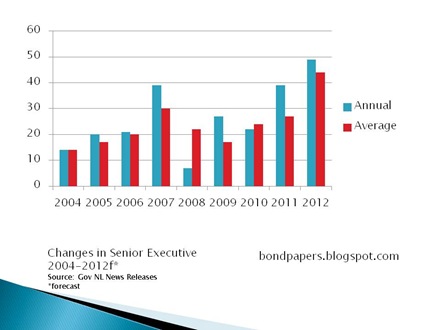Some of them – including one curious series of Twitter comments – insisted the whole thing could be put down easily to retirements because we have an aging work force. That’s an old one that local Tories have used to try to explain this away when SRBP raised it before. We’ll get to that in a little bit.
For starters, let’s bring everything up to date. The more you dig, the more curious things you find.
Getting up to date
SRBP discussed the issue on Thursday. A re-count of the number of changes in the senior executive actually made the numbers bigger than the ones cited by the Telegram.
And then on Friday, a news release appeared with four more changes to the senior executive in the provincial public service. Your humble e-scribbler decided to go back and count the announcements of changes starting in 2004.

The chart shows the total number of changes in positions in the senior public service announced by news release in the calendar year indicated. Unlike earlier counts at SRBP, these figures do not include changes at the executive director level even though these are also lieutenant governor-in-council appointments.
According to the Telegram, there were 85 positions at the senior executive rank in 2011.
Friday’s announcement brought the 2012 year-to-date total to 37, two below the annual total for 2011. The next chart shows the same data in blue and does two new things.
First, it adds a forecast for 2012 based on the current average of four changes per month in 2012. If the current trend continues, the total number of senior executive changes will be 49. Second, the red columns show a two year rolling average.

In absolute terms or on average, the number of changes over the past two years has been extraordinary. The 2011 total had only one precedent under the Conservatives, namely in 2007.
For comparison, SRBP looked at the four years of appointments between 1997 and 2000. As with the other years, the numbers came by counting the number of changes of position – including confirmations of appointment from “acting” status – as announced by the Executive Council. The results were comparable to the changes between 2004 and 2010.
| 1997 | 1998 | 1999 | 2000 |
| 22 | 31 | 17 | 22 |
Retirements
Retirements is one of the more popular explanations for the apparently abnormally large number of changes in the senior levels of the provincial public service over the past two years.
Six of the positions announced in each of 2011 and 2012 were replacements for individuals who had retired. That represents seven percent of the 85 positions identified by the Telegram at that level of the provincial public service.
Retirement accounts for some of the changes announced annually, but not all or even most of them. Most of the changes are reassignments of one senior manager from one job to another somewhere inside government.
Dawn Dalley manages Nalcor’s communications section. On Friday Dalley tweeted some interesting information that is useful to compare to the provincial government figures. Dalley was disputing the Telegram editorial suggestion that the high turn-over was a problem.
Here’s part of what Dalley wrote:
…one other note. 2006-11 (5yrs), Nalcor/Hydro has seen 263 retirements. Aging workforce. Big issue. Big bubble.
so gov has how many employees and administrators? We have 1200 or so employee base avg over that period so give or take 20%.
just saw tweet before. Need#s and drivers. Data useless (may sell papers though) without context.
Let’s deal with those last comments first. The “drivers” – the things causing the turn-over - are important. That’s what the Telegram was driving at. SRBP has also been raising the issue to see what is causing it and what it means.
The data isn’t useless, as Dalley suggests. It has a context in both the number of positions and the annual rate of change. Those numbers compared to earlier years, as SRBP has shown, gives a wider context to the numbers. The comparison confirm the unusual nature of the past couple of years. That would drive most people to further inquiry in order to to determine what is going on.
Dalley provided another context and that is useful as well. Let’s take her example of five years (not six), 1200 employees and 263 retirements. Dalley suggests that this is typical of a “big bubble” of an aging workforce.
If we average out the 263 retirees over five years and then divide by 1200, we see that Nalcor has lost about 4.3% of its workforce each year due to retirement. The provincial senior executive is almost twice that (7%).
Recent research in the United States found that retirement turn-over in senior executives in federal health care positions was comparable to private sector rates:
In recent years, [Veterans Affairs] VA experienced a decline in SES [Senior Executive Services] turnover and now reports an average turnover rate of 13 percent, with most of the SES turnover, 10 percent, due to retirements, similar to private sector industry executives.That would put the current provincial government retirement turn-over rate below that figure. The Nalcor figure doesn’t compare since it is for all employees not just those at the senior management level.
Implications
If the current trend continues, the provincial government will make 49 changes to the bureaucracy’s senior management. The total number of those positions is 85, according to the Telegram. As of September 6, the provincial government had made 37 changes to the positions.
What happens to organizational performance and morale when you change 58% of the senior managers in a given 12 month period?
Even if the 2012 figures don’t hit the level current trends suggest they will, what effect does it have when you change 45% of the positions, as the provincial government did last year?
You really can’t shift around people at those kinds of rates without producing some consequences for the organization as a whole.
That is the subject for another post.
-srbp-